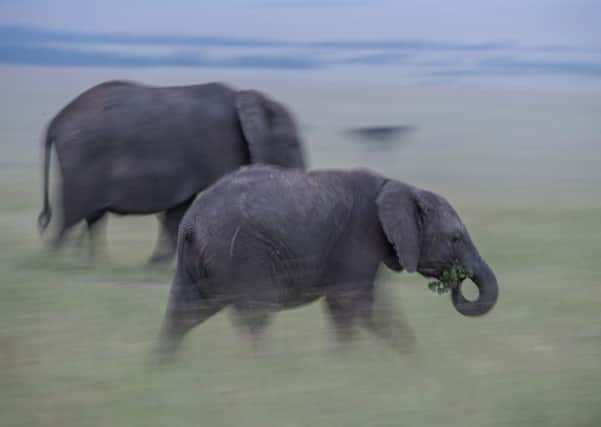Travel review: Kenya's Masai Mara


A messy break-up, the death of my first pet hamster and the scene when Elliot and ET fly across the full Moon on a bicycle have brought me close to tears.
Now, I can add a 53-year-old man in khaki shorts, wielding a Canon 1DX camera, to that list. “James, can you move forward?” bellows wildlife photographer Paul Goldstein to our safari guide and driver, who has manoeuvred us into position for a shot of two male cheetahs climbing over a fallen tree trunk. “Some diva’s complaining about a twig in her picture.”
Advertisement
Hide AdAdvertisement
Hide AdThere’s lots of foliage in Kenya’s Masai Mara in June, but this particular rogue branch is obscuring my photograph, crowning one of the cats with a race day fascinator.
As we lurch forward, the cheetah leaps up, soaring through the air like a rocket before hitting the ground in a cloud of dust. It is spectacular to watch, but not one of us gets a picture – even Paul, whose fiery temper is now a blazing inferno. Cue several choice swear words.
An award-winning wildlife photographer, Paul guides specialist tours all over the world for travel company Exodus and at the Kicheche camps, which he co-owns, in Kenya’s Masai Mara. The demand for his peculiar hard knocks school of photography is so high many trips sell out before they even make it into a travel brochure.
With vast plains and big open skies that run a spectrum from burning red to stormy blue, the Mara is an appealing canvas for any artist. But it’s the conservancies bordering the National Reserve – where we’ll be dividing our time between Kicheche’s Mara and Bush camps – that are particularly special. Lower vehicle density (there are no day trippers), the opportunity to drive off-road and a ballooning big cat population are why.
Advertisement
Hide AdAdvertisement
Hide AdBefore even reaching camp, we’re given strict dos and don’ts: Be prepared to work hard, get up early and be shouted at; don’t mention the Big 5 (“it’s a butcher’s term”), be satisfied with ‘safe’ shots, or wear a multi-pocket utility waistcoat – the last foolhardy guest to do that had his garment tossed on the bushfire.
I have borrowed a Nikon D4s, capable of shooting 11 frames per second, and two lenses from Lenses For Hire (lensesforhire.co.uk).
Our first outing begins before sunrise. We quickly find a pride of lions with cubs frolicking in the false dawn. James directs our vehicle into light, now illuminating the lions with golden halos.
I attempt to capture them play fighting, but all I seem to score is a series of backlit bum shots. “Too slow, too slow,” tuts Paul, who has fired several volleys before I’ve even touched the shutter release. “Sort yourself out!” Lesson number one: with wildlife, you have to be quick.
Advertisement
Hide AdAdvertisement
Hide Ad“Imagine every picture you take is for a calendar. Someone’s got to look at that for 30 days,” says Paul during lunch back at the camp. I vow to work harder.
Taking great pictures is also about taking risks. “If you’re prepared to fail when gambling with your camera, the potential rewards are huge,” he advises.
Slow panning – opting to track an animal with a slow shutter speed rather than freezing the action – really is going for broke, and it’s Paul’s signature style.
“Lock your arms into your body, swing down until you hit a V-shape, then fire,” he instructs.
Advertisement
Hide AdAdvertisement
Hide AdWe have another opportunity to hone our technique the following day, after hearing the great wildebeest migration has started. At 5am, we head for a tributary of the Mara, hoping to witness a crossing. Thousands of antelopes have gathered on the riverbank, galloping back and forth like athletes limbering up.
Wildebeest are famously indecisive and we wait hours for them to do something. But our patience pays off when a herd cascades down a hillside, leaping into the water to create Paul’s Holy Trinity of photographic conditions – dust, air and spume. Lesson number two: rewards come to those who wait.
Then we track a hungry cheetah, Malika, and her brood of four grown cubs. After two hours of waiting, Malika springs into action, chasing an impala straight down the barrel of my lens. She disarms the prey, but invites her cubs to finish the job.
At the end of the trip when we have to present our best work, any harsh words from Paul make his compliments seem even more significant. Paying to go on holiday with Paul is, at times, like self-flagellation, but his method delivers results. What’s more, it’s actually extremely good fun.
Advertisement
Hide AdAdvertisement
Hide AdI’m reluctant to go on safari anywhere – or with anyone – else. But isn’t that exactly the sort of behaviour you’d expect from a true diva?
GETTING THERE
Sarah Marshall was a guest of Exodus (0845 863 9601, exodus.co.uk) which offers a nine-day trip to the luxury tented Kicheche camps in Kenya from £4,599pp, including flights, food and photographic coaching from Paul Goldstein, pictured below. Next departure is August 19. Paul will also lead two 12-day photographic charters to Svalbard on June 22 and July 3, 2016, from £3,899pp excluding flights.
Kenya Airways (020 8283 1818, kenya-airways.com) operates daily overnight flights on its new B787 Dreamliner from Heathrow to Nairobi, from £722.75 return.